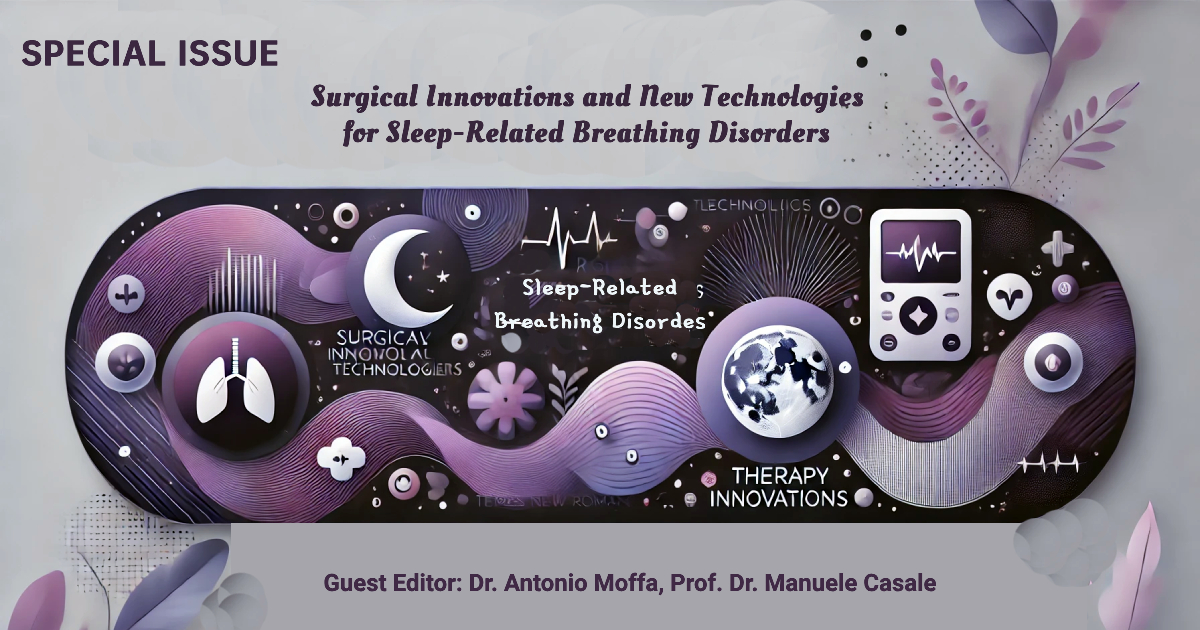- 2.7Impact Factor
- 4.7CiteScore
- 22 daysTime to First Decision
Surgical Innovations and New Technologies for Sleep-Related Breathing Disorders
Special Issue Information
Dear Colleagues,
Obstructive sleep apnea (OSA) is the most common form of sleep-related breathing disorder. It is caused by complete or partial obstruction of the upper airway, has been demonstrated to be a risk factor for several diseases, and has been correlated with other non-medical consequences that increase OSA’s clinical and economic burden. According to several population-based studies, the prevalence of OSA(S) is relatively high, at approximately 3–7% for adult males and 2–5% for adult females in the general population.
Although OSA is very common, it is a frequently unrecognized cause of serious disability, with serious health and social consequences. Currently, OSA can be diagnosed with several methods from laboratory-based to home sleep testing. To date, the gold standard method is full-night polysomnography (PSG). However, it is an expensive examination (equipment, maintenance costs, staff costs, and full-night-time occupation of the laboratory), and it can also be bothersome due to the attached sensors and the exam taking place in an unfamiliar place. For these reasons, cheaper and portable devices have been developed to detect OSA outside the hospital setting. Continuous positive airway pressure (CPAP) is often used as first-line treatment; however, failure in long-term adherence to CPAP treatment was reported in 25–50% of cases. For these reasons, in recent years, OSA and snoring surgical management underwent significant changes with the introduction of new minimally invasive surgical procedures, making OSA surgery a reasonable alternative.
We encourage authors to submit original or review articles on related topics in the field of sleep apnea. This Special Issue of Healthcare is dedicated to offering an overview of these innovations. Topics of interest include (1) new diagnostic tools for screening, (2) telemedicine and mHealth, (3) new intrapharyngeal and hypopharyngeal surgical procedures, (4) surgical and non-surgical treatment of nasal obstruction in OSA patients, (5) myofunctional and rehabilitation therapy, (6) electrical stimulation devices, (7) multimodality treatment, and (8) international research networks.
Groups from all specialties are encouraged to submit original research, project reports, short reports, reviews, and opinion papers.
We look forward to receiving your contributions.
Dr. Antonio Moffa
Prof. Dr. Manuele Casale
Guest Editors
Manuscript Submission Information
Manuscripts should be submitted online at www.mdpi.com by registering and logging in to this website. Once you are registered, click here to go to the submission form. Manuscripts can be submitted until the deadline. All submissions that pass pre-check are peer-reviewed. Accepted papers will be published continuously in the journal (as soon as accepted) and will be listed together on the special issue website. Research articles, review articles as well as short communications are invited. For planned papers, a title and short abstract (about 250 words) can be sent to the Editorial Office for assessment.
Submitted manuscripts should not have been published previously, nor be under consideration for publication elsewhere (except conference proceedings papers). All manuscripts are thoroughly refereed through a single-blind peer-review process. A guide for authors and other relevant information for submission of manuscripts is available on the Instructions for Authors page. Healthcare is an international peer-reviewed open access semimonthly journal published by MDPI.
Please visit the Instructions for Authors page before submitting a manuscript. The Article Processing Charge (APC) for publication in this open access journal is 2700 CHF (Swiss Francs). Submitted papers should be well formatted and use good English. Authors may use MDPI's English editing service prior to publication or during author revisions.
Keywords
- sleep apnea
- snoring
- sleep-related breathing disorders
- new technologies
- surgical innovations
- myofunctional therapy
- positional therapy
- mandibular advancement device and multimodality treatment

Benefits of Publishing in a Special Issue
- Ease of navigation: Grouping papers by topic helps scholars navigate broad scope journals more efficiently.
- Greater discoverability: Special Issues support the reach and impact of scientific research. Articles in Special Issues are more discoverable and cited more frequently.
- Expansion of research network: Special Issues facilitate connections among authors, fostering scientific collaborations.
- External promotion: Articles in Special Issues are often promoted through the journal's social media, increasing their visibility.
- e-Book format: Special Issues with more than 10 articles can be published as dedicated e-books, ensuring wide and rapid dissemination.

